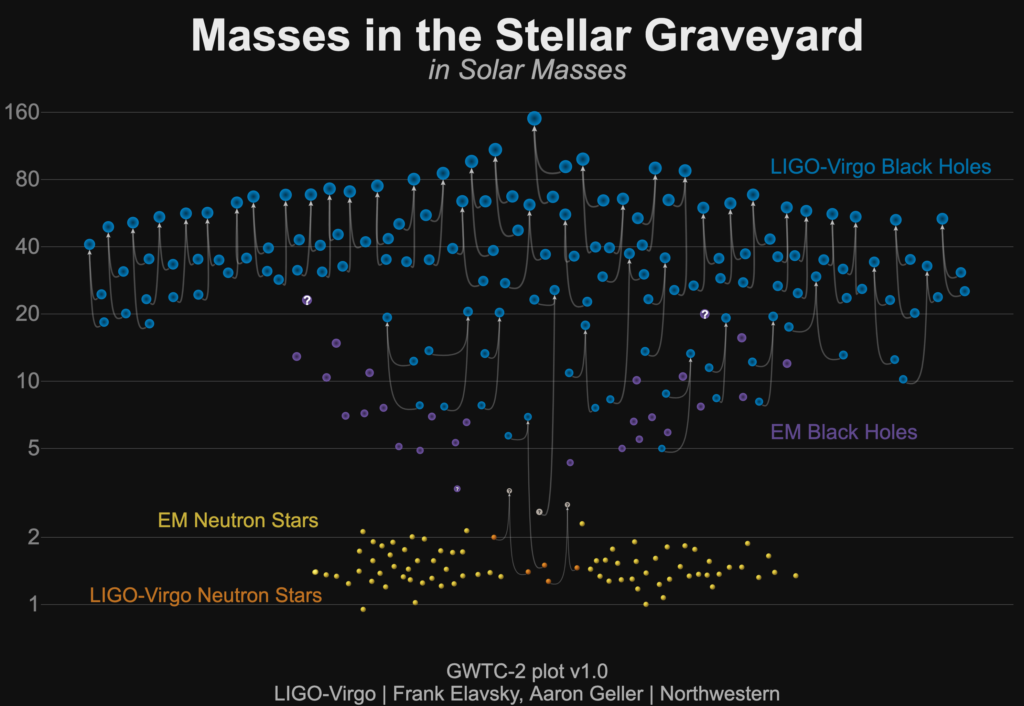After several months of thorough analysis, the LIGO Scientific Collaboration —in which the Galician Institute of High Energy Physics (IGFAE) participates— and the Virgo Collaboration have released an updated catalog of gravitational wave detections. The catalog contains 39 new signals from black-hole or neutron-star collisions detected between April 1—Oct 1, 2019, which more than triples the number of confirmed detections. The new set includes some of the most interesting systems we have seen so far, and enables qualitatively new studies of astrophysical populations and fundamental physics.
The sharp increase in the number of detections was made possible by significant improvements to the instruments with respect to previous observation periods. These included increased laser power, improved mirrors and, remarkably, the use of quantum squeezing technology. All together, these enhancements resulted in a ~60% improvement in the range to which signals can be detected. The detectors were also able to operate without interruption more often than in the past, with an improved duty cycle of ~75% vs ~60%.
With all of these new signals, we can begin to better understand the populations of black holes and neutron stars. By analyzing the entire population of binary black hole mergers simultaneously we can maximize the astrophysical information we extract. We infer that the distribution of black hole masses does not follow a simple power-law distribution. Measuring the deviations from this power law will enable us to learn about the formation of these black holes, either as the result of stellar deaths or previous collisions. Considering the entire population together also allows us to make stronger measurements of difficult to measure properties such as black hole spin. We find that some merging black holes have spins which are misaligned with their orbital angular momentum. This will allow us to probe the regimes in which these binaries formed.
We can also use the many signals in the updated catalog to put Einstein’s theory of gravity to the test in more and better ways than before. This was done by comparing the data against predictions from the theory and constraining possible deviations. The results from multiple signals were combined using new statistical methods to obtain the tightest constraints so far on the properties of gravity in the strong, highly-dynamical regime of black hole mergers. With the new catalog, LIGO and Virgo were also able to directly study the properties of the remnant objects produced during the mergers: by measuring the vibrations of these objects, and by ruling out potential “echoes” after the main signals, LIGO and Virgo confirmed that the remnants behaved as we expect from black holes in Einstein’s theory.
The results reported in the new catalog correspond to only the first six months of LIGO and Virgo’s third observing run. Results from the remaining five months are currently being analyzed. In the meantime, the LIGO and Virgo instruments are undergoing upgrades in preparation for the fourth observing run, for which they will be also joined by the KAGRA detector in Japan. More exciting discoveries are on the horizon.
Additional Reading:
- A science summary of the entire GWTC-2 catalog paper can be found here: https://www.ligo.org/science/Publication-O3aCatalog/index.php
- More detail on the first LIGO/Virgo gravitational wave transient catalog (GWTC-1) can be found in these two papers: GWTC-1: A Gravitational-Wave Transient Catalog of Compact Binary Mergers Observed by LIGO and Virgo during the First and Second Observing Runs and Binary Black Hole Population Properties Inferred from the First and Second Observing Runs of Advanced LIGO and Advanced Virgo
A visualization of 38 confirmed merging black holes that LIGO and Virgo have observed during observing runs O1, O2, and O3A. Each confirmed gravitational-wave observation has a signal at least ten times greater than the detectors’ noise. The animation shows numerical-relativity calculations of the black holes’ horizons during the final few orbits of the black holes as they spiral inwards, merge and ring down. The horizons are colored by their shapes (that is, by their intrinsic scalar curvatures). Each numerical-relativity calculation uses black-hole masses and spins that are consistent with one of the observations in the LIGO-Virgo catalog. The animation shows the final 0.30 seconds before merger for each binary. Note that GW190814 is modeled as a binary black hole, although the nature of the smaller object in the binary is uncertain. Credit: Teresita Ramirez and Geoffrey Lovelace, SXS Collaboration.
